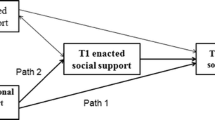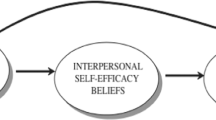Abstract
This study was designed to examine path models of the relationships of instrumentality, expressiveness, and social self-efficacy to shyness and depressive symptoms in college students. Models indicated strong relationships between social self-efficacy and instrumentality; the relationship of instrumentality to depressive symptoms was mediated by its relationship to social self-efficacy. The relationship of social self-efficacy to depressive symptoms was direct and was also mediated by its relationship to expressiveness. These findings provide new information on how gender role-related personality traits may be protective against depression.
Similar content being viewed by others
references
Bakan, D. (1966). The duality of human existence. Chicago: Rand McNally.
Bandura, A. (1977). Self-efficacy: Toward a unifying theory of behavioral change. Psychological Review, 84, 191-215.
Bandura, A. (1997). Self-efficacy: The exercise of control. Englewood Cliffs, NJ: Prentice-Hall.
Bandura, A. (2001). Social cognitive theory: An agentic perspective. Annual Review of Psychology, 52, 1-26.
Bandura, A., Pastorelli, C., Barbaranelli, C., & Caprara, G. V. (1999). Self-efficacy pathways to childhood depression. Journal of Personality and Social Psychology, 76, 258-269.
Beck, A. T., Steer, R. A., & Brown, G. K. (1996). Beck Depression Inventory manual—(2nd ed) San Antonio, TX: Psychological Corporation.
Bem, S. L. (1974). The measurement of psychological androgyny. Journal of Consulting and Clinical Psychology, 42, 155-162.
Bentler, P. M. (1995). EQS Structural Equations Program manual. Encino, CA: Multivariate Software.
Broderick, P. C., & Korteland, C. (2002). Coping style and depression in early adolescence. Sex Roles, 46, 201-220.
Browne, M., & Cudeck, R. (1992). Alternative ways of assessing model fit. Sociological Methods and Research, 21, 230-258.
Byrne, B. M. (1994). Structural equation modeling with EQS and EQSI windows. Thousand Oaks, CA: Sage.
Cheek, J. M. (1983). The revised Cheek and Buss Shyness Scale. Unpublished manuscript, Wellesley College, Wellesley, MA.
Cheek, J. M., & Buss, A. H. (1981). Shyness and sociability. Journal of Personality and Social Psychology, 41, 330-339.
Christie, V., & Segrin, C. (1998). The influence of self-efficacy and of gender on the performance of social and nonsocial tasks. Journal of Applied Communication Research, 26, 374-389.
Cook, E. (1987). Psychological androgyny: A review of the research. Counseling Psychologist, 15, 47-51.
Glass, G. V., & Hopkins, K. D. (1984). Statistical methods in psychology and education (2nd ed.). Englewood Cliffs, NJ: Prentice-Hall.
Hamer, R. J., & Bruch, M. A. (1997). Personality factors and inhibited career development: Testing the unique contribution of shyness. Journal of Vocational Behavior, 50, 382-400.
Helmreich, R., & Stapp, J. (1974). Short forms of the Texas Social Behavior Inventory: An objective measure of self-esteem. Bulletin of the Psychonomic Society, 4, 473-475.
Holt, C. L., & Ellis, J. B. (1998). Assessing the current validity of the Bem Sex-Role Inventory. Sex Roles, 39, 929-941.
Hu, L., & Bentler, P. M. (1999). Cutoff criteria for fit indexes in covariance structure analysis: Conventional criteria versus new alternatives. Structural Equation Modeling, 6, 1-55.
Hunt, M. G. (1993). Expressiveness does predict well-being. Sex Roles, 29, 147-169.
Jones, W. H., & Briggs, S. R. (1986). Manual for the Social Reticence Scale. Palo Alto, CA: Consulting Psychologists Press.
Jones, W. H., Briggs, S. R., & Smith, T. G. (1986). Shyness: Conceptualization and measurement. Journal of Personality and Social Psychology, 51, 629-639.
Jones, W. H., Chernovetz, M. E., & Hansson, R. O. (1978). The enigma of androgyny: Differential implications for males and females? Journal of Consulting and Clinical Psychology, 46, 298-313.
Leary, M. (1991). Social anxiety, shyness, and related constructs. In J. P. Robinson, R. Shaver, & L. W. Wrightsman (Eds.), Measures of personality and social psychological attitudes (pp. 161-194). San Diego, CA: Academic Press.
Leary, N. (1983). Social anxiousness: The construct and measurement. Journal of Personality Assessment, 47, 66-75.
Lengua, L. J., & Stormshak, E. A. (2000). Gender, gender roles, and personality: Gender differences in the prediction of coping and psychological symptoms. Sex Roles, 43, 787-818.
MacCallum, R. C., & Austin, J. T. (2000). Applications of structural equation modeling in psychological research. Annual Review of Psychology, 51, 201-226.
MacCallum, R. C., Roznowski, M., & Necowitz, L. B. (1992). Model modifications in covariance structure analysis: The problem of capitalization on chance. Psychological Bulletin, 111, 490-504.
Marcotte, D., Alain, M., & Gosselin, M. J. (1999). Gender differences in adolescent depression: Gender-typed characteristics or problem-solving skills deficits? Sex Roles, 41, 31-47.
Phillips, S., & Bruch, M. (1988). Shyness and dysfunction in career development. Journal of Counseling Psychology, 35, 159-165.
Robins, C. J. (1986). Sex role perceptions and social anxiety in opposite-sex and same-sex situations. Sex Roles, 14, 383-395.
Roos, P. E., & Cohen, L. H. (1987). Sex roles and social support as moderators of life stress adjustment. Journal of Personality and Social Psychology, 52, 576-585.
Russo, N. F., Green, B. L., & Knight, G. (1993). The relationship of gender, self-esteem, and instrumentality to depressive symptomatology. Journal of Social and Clinical Psychology, 12, 218-236.
Saltzman, K. M., & Holahan, C. J. (2002). Social support, self-efficacy, and depressive symptoms: An integrative model. Journal of Social and Clinical Psychology, 21, 309-322.
Schmidt, L. A., & Fox, N. A. (1999). Conceptual, biological, and behavioral distinctions among different categories of shy children. In L. A. Schmidt & J. Schulkin (Eds.), Extreme fear, shyness, and social phobic (pp. 47-66). New York: OxfordUniversity Press.
Schmidt, L. A., & Schulkin, J. (1999). Extreme fear, shyness, and social phobic. New York: Oxford University Press.
Sharpe, M. J., Heppner, P. P., & Dixon, W. A. (1995). Gender role conflict, instrumentality, expressiveness, and well-being in adult men. Sex Roles, 33, 1-18.
Shaver, P., Schwartz, J., Kirson, D., & O'Connor, C. (1987). Emotion knowledge: Further exploration of a prototype approach. Journal of Personality and Social Psychology, 52, 1061-1086.
Sherer, M., & Adams, C. (1983). Construct validation of the self-efficacy scale. Psychological Reports, 53, 899-902.
Smith, H. M., & Betz, N. E. (2000). Development and validation of a scale of perceived social self-efficacy. Journal of Career Assessment, 8, 283-301.
Smith, H. M., & Betz, N. E. (2002). An examination of efficacy and esteem pathways to depression in young adulthood. Journal of Counseling Psychology, 49, 438-448.
Spence, J. T., & Buckner, C. E. (2000). Instrumental and expressive traits, trait stereotypes, and sexist attitudes: What do they signify? Psychology of Women Quarterly, 24, 44-62.
Spence, J. T., Helmreich, R. L., & Stapp, J. (1974). The Personal Attributes Questionnaire: A measure of sex role stereotypes and masculinity–femininity. JSAS: Catalog of Selected Documents in Psychology, 4, 43-44. (Ms. No. 617)
Spence, J. T., Helmreich, R. L., & Stapp, J. (1975). Ratings of self and peers on sex-role attributes and their relation to self-esteem and conceptions of masculinity and femininity. Journal of Personality and Social Psychology, 32, 29-39.
Stake, J. E. (1997). Integrating expressiveness and instrumentality in real-life settings: A new perspective on the benefits of androgyny. Sex Roles, 37, 541-564.
Ward, C. A. (2000). Models and measurement of psychological androgyny: A cross-cultural extension of theory and research. Sex Roles, 43, 529-552.
Watson, D., & Friend, R. (1969). Measurement of social-evaluative anxiety. Journal of Consulting and Clinical Psychology, 33, 448-457.
Whitley, B. E. Jr., (1984). Sex-role orientation and psychological well-being: Two meta-analyses. Sex Roles, 12, 207-225.
Woodhill, B. M., & Samuels, C. A. (2003). Positive and negative androgyny and their relationship with psychological health and well-being. Sex Roles, 48, 555-565.
Author information
Authors and Affiliations
Corresponding author
Rights and permissions
About this article
Cite this article
Hermann, K.S., Betz, N.E. Path Models of the Relationships of Instrumentality and Expressiveness to Social Self-Efficacy, Shyness, and Depressive Symptoms. Sex Roles 51, 55–66 (2004). https://doi.org/10.1023/B:SERS.0000032309.71973.14
Issue Date:
DOI: https://doi.org/10.1023/B:SERS.0000032309.71973.14




